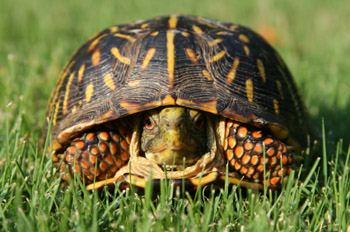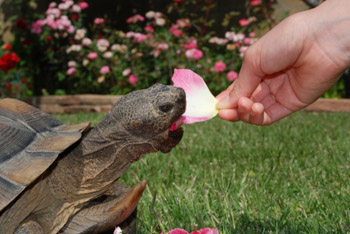Turtles: Hibernation
Hibernation is the state of dormancy coinciding with the cold of winter.
Brumation is a term used by some to specify hibernation in reptiles as separate from that in mammals.
Estivation is a biological method used to avoid harsh environments during summer months. It is thought to be a method to conserve water.

Hibernation In More Detail:
Hibernation is thought to occur mainly in response to endogenous cues such as short day length and the onset of cooler weather. This coincides with environmental conditions that cause a decline in suitable food sources and climatic conditions that are not conducive for normal reptile behavior.
Endogenous cues include seasonal hormonal cycles and the accumulation of specific amino acids and neurotransmitters.
During hibernation, there is substantial depression in metabolic function. Digestion ceases, cardiovascular function (including blood circulation) is greatly reduced and the immune and other defense systems slow down or stop. A turtle that is preparing to hibernate becomes sluggish and has a decreased appetite.
To Hibernate Or Not To Hibernate?
Hibernation depends upon the natural environment of the turtle and tortoise. Not all turtles and tortoises hibernate. Turtles and tortoises from tropical or subtropical areas generally do not hibernate. An easy way to make an educated guess as to whether or not a turtle hibernates is to determine if it originates from an area close to the equator. Those naturally found in more temperate areas, where winter cooling is significant, are most likely to go through a period of hibernation.
Many pet turtles never hibernate because of the simple fact that they are kept indoors in an environment with constant conditions. There are no cues for hibernation, and basically it is unnecessary. Where and how a turtle hibernates can often vary. This depends on the type of environment that it normally inhabits.
The Hibernation Requirements Chart below briefly outlines hibernation requirements for some of the more common pet turtles and tortoises.
Hibernate in Good Health!
Because of the changes that turtles undergo during hibernation, disease can develop quickly, and even mild or minor complaints can turn into major problems during hibernation. For this reason you should never hibernate sick or injured turtles or tortoises!
These questions should be asked to determine if a turtle is healthy enough to hibernate:
- Is the turtle's nose dry?
- Are the eyes clear and free of discharge?
- Are there any defects or abnormal areas of softness or discoloration on the shell?
- Are there any recent wounds, abscesses, or cuts on the legs, head or neck?
- Has the turtle eaten well over the summer?
- Is there an adequate supply of fat around the shoulder and leg areas?
If there is any doubt, DO NOT hibernate. Bring the animal indoors and provide adequate warmth, lighting, food and water to maintain normal activity.

Coming Out of Hibernation
As the weather warms up, generally between the months of March and May (depending on where you live), the turtle or tortoise begins to stir. At this time, it can be taken outside and offered water. Normal appetite should return within a week or two.
Hibernation Requirements of Common Pet Turtles and Tortoises
| Name of Turtle | Natural Environment | Hibernation Requirements |
| Red-Eared Sliders Aquatic Turtle | Southern United States Freshwater | If kept indoors, no hibernation needed. Outdoor pond: will hibernate underwater or in leaves/mulch around pond. In colder areas water must be deep enough that turtle can remain under frozen upper layers of water. |
| Box Turtles | North America; Woodlands or Grasslands | Mulch pile of leaves/grass clippings, small dog house. Be sure area will not be flooded by rain. Mulch can be placed in garage. Some moisture is required in any setup. |
| Desert Tortoises | North America; Southwest Deserts | Outdoor burrow if deep enough, safefrom flooding. Can also place in dry box with dry grass clippings and keep in cool closet or under a bed. |
| African Spurred Tortoises | Africa; Northern Arid Lands | Do Not Hibernate! Provide adequate heat and dry enclosure. Can use small doghouse elevated off of damp ground. |
[ Search Articles ] [ Article Index ]
